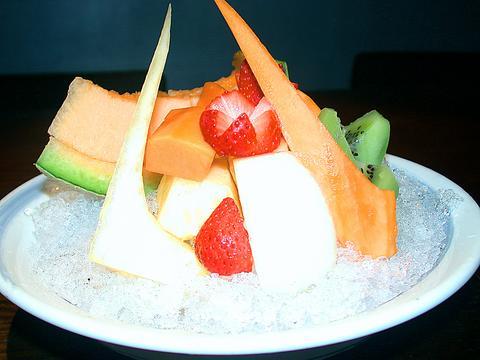One of the better restaurants in town, Shintori (Cuisine Japonaise) has an ornamental bamboo grove outside and oozes class inside, with its attention to design and stripped-down neo-industrial look. The ambience of the place, fortunately, is matched by the service and food.
Comprising a main seating area -- which is set off from the sashimi bar by a large etched plate-glass window -- there is an open kitchen, tunnel-like corridors and faux bridges or water-themed decorative elements. The restaurant also has many private booths that cater to groups of friends, families or a romantic tete-a-tete, that are set up like small sitting rooms, with simple wooden tables, a decorative highlight or freshly cut flowers.

PHOTO: JULES QUARTLY, TAIPEI TIMES
Dinner began with tea and not just any old cha -- a light and fragrant oolong, or clean-tasting green tea -- before moving on to starters that were inventive and genuinely appetizing. "Cubic appetizers" was a nine-box assortment of sushi and sashimi in little black-and-white colored boxes. Rock 'n' roll salad sounded intriguing but I plumped for the rice and salmon flakes in tea soup, which was tasty and powerfully fishy with the addition of small, orange globes of roe.
Main course choices included a sashimi salad with an amazing confection of varied green leaves and hearts of lettuces, along with radishes, baby corns and raw fish, sprinkled with in an elegant dressing. I chose the grilled XXL chicken on a skewer, which arrived with dried chili and cracked pepper, over the promising beef hot pot, grilled black bass filet with buckwheat, and assorted tempura platter. The chicken was good, with extra points for the subtle lemon grass flavoring.
The owners have clearly gone for "zen-style cooking," which they claim has evolved from food served in temples and "the simple diet of Buddhist priests ... into a creative and interesting cuisine." It works, I think, because of good management. There are four Shintori company restaurants in Taipei (which include the People bar and fusion restaurant further down Anhe Road that has become popular with media and business types), with three more in Shanghai. Attention to detail makes the restaurant chain stand out.

April 14 to April 20 In March 1947, Sising Katadrepan urged the government to drop the “high mountain people” (高山族) designation for Indigenous Taiwanese and refer to them as “Taiwan people” (台灣族). He considered the term derogatory, arguing that it made them sound like animals. The Taiwan Provincial Government agreed to stop using the term, stating that Indigenous Taiwanese suffered all sorts of discrimination and oppression under the Japanese and were forced to live in the mountains as outsiders to society. Now, under the new regime, they would be seen as equals, thus they should be henceforth

Last week, the the National Immigration Agency (NIA) told the legislature that more than 10,000 naturalized Taiwanese citizens from the People’s Republic of China (PRC) risked having their citizenship revoked if they failed to provide proof that they had renounced their Chinese household registration within the next three months. Renunciation is required under the Act Governing Relations Between the People of the Taiwan Area and the Mainland Area (臺灣地區與大陸地區人民關係條例), as amended in 2004, though it was only a legal requirement after 2000. Prior to that, it had been only an administrative requirement since the Nationality Act (國籍法) was established in

Three big changes have transformed the landscape of Taiwan’s local patronage factions: Increasing Democratic Progressive Party (DPP) involvement, rising new factions and the Chinese Nationalist Party’s (KMT) significantly weakened control. GREEN FACTIONS It is said that “south of the Zhuoshui River (濁水溪), there is no blue-green divide,” meaning that from Yunlin County south there is no difference between KMT and DPP politicians. This is not always true, but there is more than a grain of truth to it. Traditionally, DPP factions are viewed as national entities, with their primary function to secure plum positions in the party and government. This is not unusual

US President Donald Trump’s bid to take back control of the Panama Canal has put his counterpart Jose Raul Mulino in a difficult position and revived fears in the Central American country that US military bases will return. After Trump vowed to reclaim the interoceanic waterway from Chinese influence, US Defense Secretary Pete Hegseth signed an agreement with the Mulino administration last week for the US to deploy troops in areas adjacent to the canal. For more than two decades, after handing over control of the strategically vital waterway to Panama in 1999 and dismantling the bases that protected it, Washington has